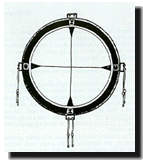
According to Mi’kmaq mythology, the Great Spirit
shaped a piece of clay, as red as the skin of the
Mi’kmaq people, into a crescent and lay this
“Minagoo” in the singing waters of the Gulf of
St. Lawrence. It was the most beautiful place of all on
Mother Earth and, for a time, the Mi’kmaq had it all
to themselves .
.
The easternmost tribe of the Algonquin family, the
Mi’kmaq, most often came to the Island, which they
called Abegweit, during the summer season to camp and
fish. Early French writers such as Champlain and
Lescarbot referred to the Aboriginals they encountered as
“Souriquois.” In 1693, they were given the name
“Mi’kmaq” or allies, but they referred to
themselves as “Epegoitnag.”
The Mi’kmaq suffered great hardships as a result of
European colonization of the Island. The government took
their lands, ruined their hunting grounds, burned the
forests, depleted wild game on which the people depended
for their livelihood, and segregated the Mi’kmaq
from the rest of the population by forcing them onto
reservations (Lennox Island, Scotchfort, Rocky Point, and
Morell). And, for most of the twentieth century, the
federal government pursued an active policy of
assimilation of the country’s Aboriginal peoples.
But the Mi’kmaq proved themselves to be a resilient
people, allying themselves with the French during the
wars between Britain and France, fighting in two world
wars, and struggling to preserve their culture and
traditions. Their efforts were not in vain. Today, the
Prince Edward Island Mi’kmaq community is host to an
important annual event for Aboriginal peoples throughout
Atlantic Canada and the northeastern United States.
During the third weekend in August, a three-day powwow is
held at the Panmure Island cultural grounds. This event
is filled with storytelling, song, dance, and drumming.
 Two
vital elements of the powwow are the sweat lodge and the
sacred fire. The sweat lodge is an activity of great
spiritual significance in Mi’kmaq society. It is a
time for healing and cleansing, providing a sacred
occasion to spend time with the Creator. The sacred fire
is lit at the opening of the powwow and burns
continuously until the end of the three days.
Participants approach the fire throughout the weekend to
present themselves and give honour to the Creator through
prayer. The sacred fire is never left unattended; there
is always a participant in prayer.
Two
vital elements of the powwow are the sweat lodge and the
sacred fire. The sweat lodge is an activity of great
spiritual significance in Mi’kmaq society. It is a
time for healing and cleansing, providing a sacred
occasion to spend time with the Creator. The sacred fire
is lit at the opening of the powwow and burns
continuously until the end of the three days.
Participants approach the fire throughout the weekend to
present themselves and give honour to the Creator through
prayer. The sacred fire is never left unattended; there
is always a participant in prayer.
In the course of their prayer, participants give
recognition to the water and to all plant and animal
life. At the sacred fire, they pray to the four cardinal
directions, giving honour to the times of human life. The
East, from where the sun rises, signifies the beginning
of life, and spring. The South represents the summer and
a time of youth and learning. Prayers giving respect to
the West honour maturing and participation in the
advancement of the people. The North is honoured as
participants celebrate the time to prepare for death and
renewal. The four colours of humanity—black, white,
red, yellow—are given equal value in these rites as
are the four elements—fire, water, air, and earth.
The Mi’kmaq people also express their faith through
the Roman Catholic Church. On
June 24, 1610, Grand Chief Membertu and twenty of his
braves were baptized in Port Royal. Today, this
monumental event is celebrated and renewed on the day of
the patron Saint of the Mi’kmaq, St. Anne’s
Sunday, which is marked by pageants, games, music, and
dance.
Mi’kmaq arts and culture are still practised by
diverse individuals and groups in Prince Edward Island
and in Atlantic Canada. Red Stone and Lonewolf, for
example, are two Island Mi’kmaq drumming and
chanting groups that have achieved a wide audience across
the province.
The Irish | Acadians and Francophones | Multiculturalism
The English | The Scots
